(First presented at the Eighth Annual Conference of The Lucidity
Association, in Santa Cruz, June 28, 1992)

ABSTRACT: Many researchers define a lucid
dream as one in which dreamers realize, however vaguely, that they dream
while they dream. However, in dream-life as in waking-life, lucidity ranges
across a continuum, and may depend on a number of factors.
These include the ability to think clearly, the ability to remember, the
power to control the dream, the feeling of embodiment, reality tone or
vividness, the emotional content of the dream, and the sense of self of the
dreamer. Despite the many factors involved, the experience of
lucidity depends most closely on the interaction of two factors that
together determine the freedom of choice experienced by the dreamer in the
dream. The first corresponds to clarity of thought and perception, and the
second with the power to control the dream.
By looking at the degree to which
a dreamer has made covert assumptions overt, and at the degree to which the
dreamer can act on this knowledge, one can evaluate dreams on a scale that runs
the gamut from ordinary dreaming to super-lucidity. The author has developed a
series of maps of consciousness that illustrate the differences between many
different kinds of both lucid and non-lucid dreams.
INTRODUCTION
What exactly do dreamworkers mean by the term lucidity?
In common usage, one might define it as an aspect of awareness characterized by
clear perception and understanding. Many researchers define a lucid dream as
one in which dreamers realize, however vaguely, that they dream while
they dream. Although dream lucidity by accepted definition depends most
strongly on the awareness of dreaming, a number of other factors also play
important roles. These include such parameters as the ability to think clearly,
the ability to remember, the power to control the dream, the feeling of
embodiment, the reality tone or vividness of the dream, the emotional content of
the dream, and the sense of self of the dreamer.
For the moment, let us take lucidity in the limited
sense to mean a mental state characterized by clarity in thought and
perception. I have found that I can evaluate this best in a dream by looking at
the degree to which the dreamer has an overt awareness of the complex of
previously unquestioned assumptions that comprise what phenomenologists call the
natural attitude towards the world. Basically, this meta-schema
includes such judgments as that we live physically as human beings in
"objective reality", that physical objects exist independent of our awareness of
them, that events juxtaposed in space-time exist in some sort of a cause and
effect relationship, and that we experience a "physical universe" directly and
without significant distortion, etc. Ordinarily, dreamers continue to apply
this natural attitude to their experience while dreaming.
By looking at the degree to which
I have made such covert assumptions overt, I can evaluate the degree of lucidity
attained.
In ordinary dreams, I usually make a covert global
judgment that: (dream experience) = (waking physical reality experience). In a
minimally lucid dream, one gains a conscious awareness of this
judgment and then replaces it with another judgment in
line with one's cultural or personal prejudices about the nature of dreams. For
example:
1. (dream experience) = (the purely subjective
projections of one's sleeping brain); or
2. (dream experience) = (an independently existing spirit
world); or
3. (dream experience) = (a parapsychological realm with
both subjective and objective elements); or any number of other possibilities.
Once made, the judgment often becomes covert and unquestioned.
Some western researchers believe that an unquestioning
acceptance of the currently popular neurophysiological theory about the nature
of dream experience, as summarized in judgment #1, constitutes full lucidity.
To me, such a limitation and definition seems both naive and premature.
Ironically, current neurophysiological theory supports this view as it proposes
that each of us lives in a virtual reality regardless of our state of awareness,
whether waking or sleeping. This theory posits that each of us do not, indeed
can not, directly experience objective physical reality, but only our own,
hypothetically more or less adequate, mental representation of it. If so, then
all of the physical world (including one's physical brain) becomes a dubious
construct known only by inference, as we can only confirm its existence
indirectly. As Stephen LaBerge (1985) wrote in his book, Lucid
Dreaming:
"The dream body is our representation of our physical body. But it is the only
body that we ever directly experience. We know, by direct acquaintance, only
the contents of our minds. All of our knowledge concerning the physical world,
including even the assumed existence of our "first", or physical bodies, is by
inference."
By most definitions, a lucid dreamer must at least
understand that his or her experience does not take place in an objective,
physical world. However, even the major insight that (dream reality  waking
physical reality) only begins the task of unmasking assumptions, as the dreamer
may still operate through a residuum of unquestioned beliefs and judgments. For
example, I may dream of my brother Scott, yet even on realizing that I dream, I
might naively continue to identify the (dream Scott) with the (physical reality
Scott) without qualification. I do this despite the fact that the two may even
differ greatly in appearance. Rather than simply replacing one set of
unexamined beliefs with another, from a phenomenological viewpoint true lucidity
requires first gaining an overt awareness of one's beliefs, and then after
suspending judgment in them, shifting the focus of one's attention to the
apodictical realm of the directly experienced (Kellogg, 1989). Edmund Husserl
(1859-1938), the founder of the phenomenological movement called this
fundamental shift in perspective the epoché, or
phenomenological reduction, (see Husserl, 1973, Natanson,
1973, and Zaner, 1970), and I will use brackets [ ] in this paper to indicate
examples of its use ( e.g. [Scott] rather than Scott). waking
physical reality) only begins the task of unmasking assumptions, as the dreamer
may still operate through a residuum of unquestioned beliefs and judgments. For
example, I may dream of my brother Scott, yet even on realizing that I dream, I
might naively continue to identify the (dream Scott) with the (physical reality
Scott) without qualification. I do this despite the fact that the two may even
differ greatly in appearance. Rather than simply replacing one set of
unexamined beliefs with another, from a phenomenological viewpoint true lucidity
requires first gaining an overt awareness of one's beliefs, and then after
suspending judgment in them, shifting the focus of one's attention to the
apodictical realm of the directly experienced (Kellogg, 1989). Edmund Husserl
(1859-1938), the founder of the phenomenological movement called this
fundamental shift in perspective the epoché, or
phenomenological reduction, (see Husserl, 1973, Natanson,
1973, and Zaner, 1970), and I will use brackets [ ] in this paper to indicate
examples of its use ( e.g. [Scott] rather than Scott).
A detailed description of the epoché lies
beyond the scope of this paper, but for demonstration purposes try to question
whether at this moment you really experience this presentation in an
objective physical reality. Consider seriously some alternatives. For
example, you may find yourself caught up in a very realistic dream, hallucinate
due to a hypnotic suggestion or a mind altering drug, or in these days of
advanced technology, undergo unknowingly exposure to an advanced virtual reality
set-up in cyberspace. If you find this difficult, you may want to read Tart's
(1986) presentation on "Consensus Trance: The Sleep of Everyday Life" to get a
better idea of some of the inner constraints that may prevent you from
accomplishing this exercise. None of these possibilities seems likely, but if
you can move beyond the naive certainty of the natural attitude, you can
recognize at least a theoretical possibility and can, in fact, doubt. Tholey's
(1983) successful approach to inducing lucid dreams through the development of a
"critical reflective attitude" in ordinary waking life, wherein one asks: "Am I
dreaming or not?", also approximates the beginning of a movement towards the
"phenomenological attitude" that results from the straightforward application of
the epoché.
If you can shift your focus to the realm of direct
experience after suspending judgment, you can complete the process of the
phenomenological reduction. After the epoché, both "Waking
Physical Reality" (WPR) and "Dream Reality" (DR) become only
special cases of a more general "Experiential Reality" (ER). Regardless
of how you wish to explain your present experience (WPR, DR,
hypnotic imagery, etc.), the [experience] remains. The epoché
can allow one to move towards greater lucidity in ordinary waking life, and as
such it can serve as both a model and a preparation towards the development of
lucidity in one's dream life. When I perform the epoché my whole
attitude towards the lifeworld changes, as dramatically as it does when I "wake
up" in a dream. Both dream lucidity and the epoché require an
awareness of formerly unconscious judgments in order to occur, and both can
proceed more or less adequately in each particular circumstance.
MAPPING TERRITORIES
I normally recall 3 to 5 dreams per night, and have
written down and indexed well over 7,000 dreams. Of these dreams I've
categorized 500 or so as lucid to a greater or lesser degree. The "maps of
consciousness" presented here describe my own experiences in the "lucidity
continuum", and do not depend upon, or derive from, the experiences of other
lucid dreamers. Even so, my work has received some consensual validation in
the sense that other lucid dreamers with whom I have shared my maps have
generally found value in them as diagnostic and descriptive tools.

Figure 1
To begin, I must first present a basic diagram of how I
ordinarily experience myself. In Figure 1 I've diagrammed a
relevant two dimensional section of my four dimensional consciousness process.
For present purposes, thinking, feeling, and knowing each
corresponds to a different depth in intentionality. By intentionality I
mean the fundamental act by which consciousness directs itself at something
within experience. Simplistically, by thinking I mean that aspect of
myself that labels, and works with abstractions; by feeling that aspect
which attributes meanings and significance to things; and by knowing,
that aspect of creativity that structures pure experience. These three
"levels" coexist in a hierarchical order, with thinking as the most superficial
(closest to the "outside" world), feeling occurring at greater depth, and with
knowingness occurring at the greatest depth, closest to the functioning of what
I experience as my essential source-self. Each level contains many different
aspects, and I have delineated some of these in the "Lucidity Correlates"
questionnaire that I developed included as Appendix A.
Let me try and make this clear by example. "Looking
across the room I see a chair next to the doorway". In perceiving the chair, I
see it first as a particular structure or form, and differentiate it from
my experience as a whole; I impose meaning on the form, and see it as a
stationary object, made out of wood, on which a person can sit, etc. I
understand this at a glance without words. Finally in my thinking I may
label this object a "chair" or more specifically as a "ladderback shaker
style chair". All of this occurs automatically and routinely, and with little
apparent conscious effort. We take this tremendous activity for granted, and
even talk about consciousness as "passive"! Try the exercise for yourself on a
variety of objects paying attention to how you intend the structure, the
meaning, and finally the labeling of a particular object. At each level of
intentionality we can make choices about how we intend an object, what we choose
to call it, how we choose to use it, and even how we choose to perceive it. If
you have trouble "restructuring" an object, look at Figure 2, and
notice how the object perceived changes depending upon whether you "view" the
figure from above or below, as a three-dimensional cube or as a two-dimensional
diagram. In a very demonstrable sense each of us creates, or more specifically
intends, our own reality. Husserl termed this automatic, and many layered
making sense out of the world functioning intentionality. As I'll
describe below, the operation of functioning intentionality can change
dramatically in the dream state.

Figure 2
THE LUCIDITY CONTINUUM
ORDINARY WAKING (Figure 3)
With this as a necessary prologue, we can now look at the
figures that present the "maps of consciousness" associated with different
stages of the lucidity continuum, from "awake" to "asleep". Figure 3
portrays my ordinary waking consciousness, and we will begin by studying its
schematics in detail. The area inside of the parabola represents my field of
consciousness, and the area outside corresponds to physical reality. The
transparency or opaqueness of the limiting line of the parabola indicates my
awareness or non-awareness of the physical world. The illuminated area within
the parabola represents the light of awareness that defines my experienced self
and the functioning available to it, in this case mostly cognitive. Oddly
enough, no matter how dramatically my sense of self changes, the essence of self
(source-self on the diagram) does not appear to change. In waking physical
reality (WPR), I usually have my identity focus and "center of gravity"
in the thinking levels; e.g. feelings happen to me, and I have little direct
conscious control over them. The shaded area corresponds to the "unconscious"
of the experienced self as presently constituted. Please note that this does
not mean unconscious in any other sense.

Figure 3
Before continuing further, I need to point out that the
"bubble of awareness" that portrays the sense of self in actuality continually
shifts and changes: amoebalike, it extends pseudopodia of awareness, "making
the unconscious conscious". Although this may sound esoteric, we do it all the
time. A moment's attention on the previously unnoticed sensations of your rear
end against the chair, or of the memory of your second grade teacher's face
should establish this fact adequately. Thus, although I will characterize a
particular dream as predominantly sub-lucid, semi-lucid, etc., lucidity varies
from moment to moment to a greater or lesser degree. Due to the limitations of
the medium, each figure presented here can only depict an averaged approximation
to the predominant mode of consciousness that it portrays.
Note: In the dream accounts to follow I will use
quotation marks
( ' ' )to indicate obvious discrepancies in identification with
WPR standards, noticed after waking up from the dream upon later
reflection. For example, if I dream of my friend Dave, and if the dream
character did not even particularly look like him, I will denote this dream
character as 'Dave'. On the other hand, if I denote the dream character as
[Dave] using brackets, this means that while dreaming I not only noticed
any discrepancies but that I suspended judgment in the metaphysical identity of
the dream character, but focused instead on what I directly experienced.
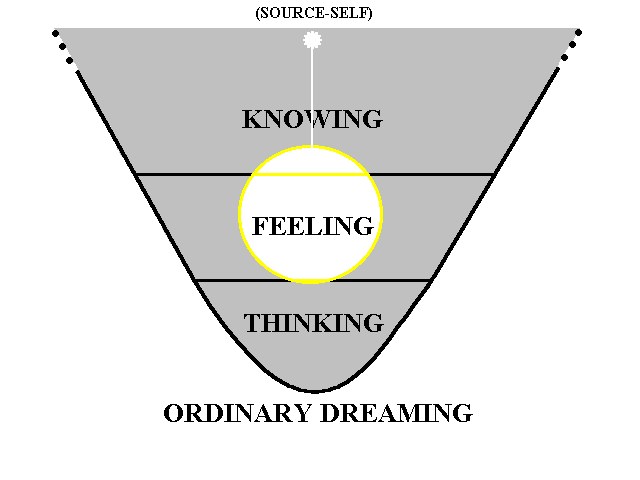
Figure 4
ORDINARY DREAMING (Figure 4)
In dream reality (DR), my center of gravity shifts
to the feeling level. In ordinary dreaming I have very limited use of my
thinking aspect, and have very little memory of the ordinary state of affairs of
my WPR existence, including my name, address, age, and even physical body
type.
EXAMPLE:
"As a 'little boy' in an Austrian city - grabbed and imprisoned by 'Christopher
Lee', a government agent, who feels convinced that I know some scientific
secrets from an old professor who just died. I don't, but he remains darkly
convinced. I dive into a river to escape - make it to an island park, but guess
my 'red' hair will get me noticed and captured. Later, I get captured again,
now as a 'little black boy' - I try to contact information and a book of magic
falls from the shelves. I put a diagram on the board, and put the paper
protection spell under the desk top. Just in time. 'C.L.' comes in grabs my
left hand and looks at the palm and middle finger, as if he could read the
secret he so desires there. I tell him he has one year to tell me explicitly
what he wants, and that if he does, I will help him, but after that time I will
never help, as I have tolerated enough of his treatment and will stand no more.
He doesn't seem cruel or evil, just obsessed" 1/10/1990
Comment: While dreaming, my ability to critically reflect
on my experience using WPR standards deteriorates to a greater or lesser
extent depending upon the degree of lucidity attained. Even if fully lucid I
need to make a conscious effort not to jump to conclusions about the nature and
identity of dream objects. In the case of ordinary dreams, my ability to notice
discrepancies between the dream and my ordinary WPR experience can seem
practically nonexistent. I can incarnate in bodies young or old, male or
female, human, animal, or alien, and find myself in locales ranging from
Arcturus to ancient Atlantis without noticing anything in the least peculiar.
Paradoxes, incongruities, discontinuities, and anachronisms make little or no
impression on me. I act according to how I feel in the moment, and do little or
no thinking.
PRE-LUCID
In the
dream, I notice some sort of bizarreness as unusual for waking physical reality (WPR). Or I don't consider myself in ordinary
physical reality at all, although I realize almost none of the implications and
still misidentify the actual situation.
EXAMPLE:
"... time traveling into the future, I look in a paper for stock quotations. I
sit down and get interrupted by an inspection team of 'Mormons' in black
gowns. I tell them that I've come from the past - but the paper has a July 24,
1939 date! I test my abilities, and break off a piece of a heavy wooden table.
They try to restrain me, 'Angus' tries to stop me, and I beat him to a pulp.
Alarms go off and they release a red gas in the corridor to poison me or knock
me out. I break through a wall and get away." 5/3/89
Comment: Although not aware that I dreamed, I did notice
some discrepancies, and even thought to take advantage of the time traveling
situation to better my financial status. On the other hand, I reacted
emotionally and violently to an attempt at restraint, and identify a dream
character with a childhood enemy named Angus, who looked nothing at all like
him.

Figure 5
SUB-LUCID (Figure 5)
Although I vaguely realize that I dream, it does not even
occur to me to act differently based on this knowledge. I continue to follow
the dream "script": no conscious choice.
EXAMPLE:
"In a magic shop, a man offers magical objects in exchange for my doing some as
of yet unspecified task. My guide takes his time, but I realize that he better
hurry up and ask me the task before I wake up. I get a cloak of invisibility -
ornate, black cloth on inside, embroidered white and red on the outside. Also
brass arm things, wicked looking, that I refuse as they would slow me up. I see
a battered Magica De Spell plastic doll 2-3 inches high with green glasses, and
ask if it comes with foof bombs - it does. He throws one at me, like a
combination cherry bomb/sparkler, not very incendiary either. I return to WPR
without ever having learned the task." 10/16/90
Comment: In this case I knew that I dreamed, but did not
experience an increased freedom of choice because I had no awareness of other
choices. For example, it did not occur to me to try techniques that have
worked well for me in the past for prolonging a lucid dream, despite my concern
in this regard. I followed the dream script not out of choice, but because I
saw no alternative course of action. I also assumed that these magical objects
would follow me to WPR, and did not remember that my past experience in
this regard has so far proven consistently otherwise.
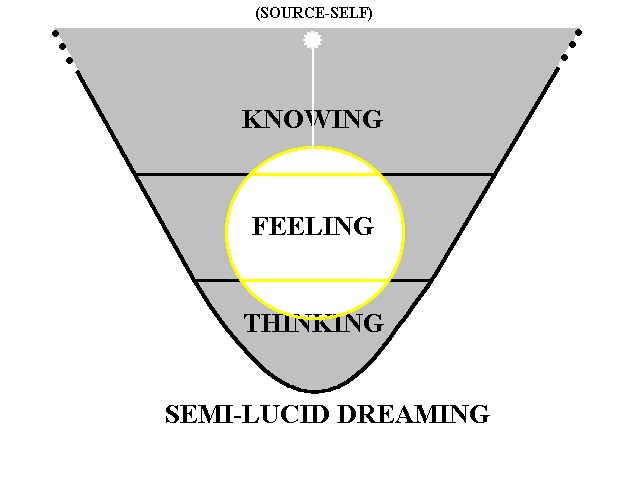
Figure 6
SEMI-LUCID (Figure 6)
I know that
I dream, and although I still follow the dream script, I can make new choices
based on this awareness. For example, I might choose to fly rather than walk.
EXAMPLE:
"... I see a huge (big as a
house) steamroller, tank-car bearing down on me as I stand in the middle of the
street. Knowing that I dream, I choose to face it and transform myself into a
superhuman state: my forearms bulge whitely with strength, as I expand and
densify - but the machine still dwarfs me. As the [machine] bears down on me I
don't know if I have changed enough to stop it, but I stand resolute, and tear a
hole right through it to the other side, walking through the mass of metal as if
I went through paper maché." 3/6/90
Comment: Although my thinking still seemed a bit
clouded, I remember this dream with great fondness, in that I faced my fear and
triumphed over adversity. What choices I did make had power, and depended upon
my having an overt awareness of the dream state. In this particular example of
semi-lucidity I would draw the "bubble of awareness a little differently then
in Figure 6, by extending it a little more deeply into knowing to
depict the increase in dream control.
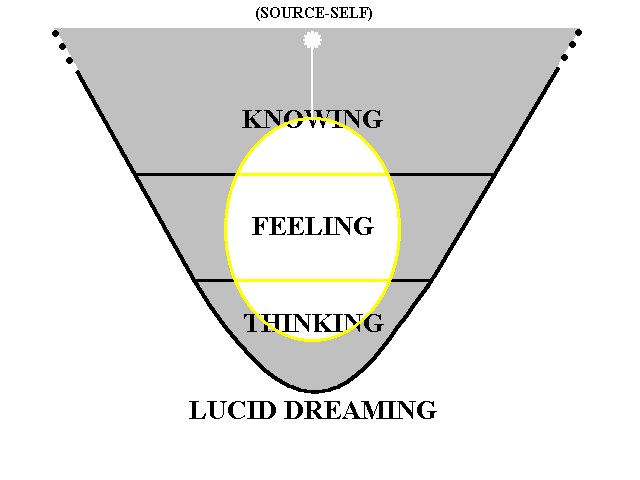
Figure 7
LUCID (Figure 7)
I have the
choice of following the dream script or not, can make major choices based on
awareness of my potentialities in the dream state. For example, I might choose
to try a dream experiment instead of continuing the dream scenario, etc.
EXAMPLE:
"I find myself in a sort of
1960 blue Chevy, and wake up to lucidity. I decide to try to use the [car] to
go to [Mt. Shasta], to meet Julie, as I've had problems flying long distances.
The dash has a computerized LCD display, and the [car] seems a sort of disguised
space vehicle. I have trouble punching in the controls, but look for a voice
operated control. However, before I take off I seem to hear [Julie's voice]
calling "Wait! Wait!" And I see [Julie] rushing up to get in. She looks like
Julie (WPR), but a little dull eyed, and I suspect a substitute. I
certainly don't feel the presence that I've felt with others who seemed
authentic. So I decide to go to [Mt. Shasta] anyway to check out the site, see
if I can find a counterpart to the WPR Julie. Set the [car] for
hyperdrive, it takes off flying and after a few loops and spins, I see an
incredible view of the landscape below as it rushes by, green and beautiful. If
I do dream with Julie, she should remember the view later when we compare
dreams. The [car] only travels a few hundred mph, and when I try to speed up I
return to WPR instead." 7/21/91
Comment: Lucidity in this case involved a fairly detailed
appreciation of the situation, and of an overt awareness of the "substitution
phenomenon" anomaly (Kellogg, 1985), which occurs when dream characters, objects
and locations display incongruities with the WPR counterparts with which
I identify them. In this dream I tried to connect through a mutual dream with a
friend of mine who had actually gone to climb Mt. Shasta. She, incidentally,
had no recall of any corresponding dream.
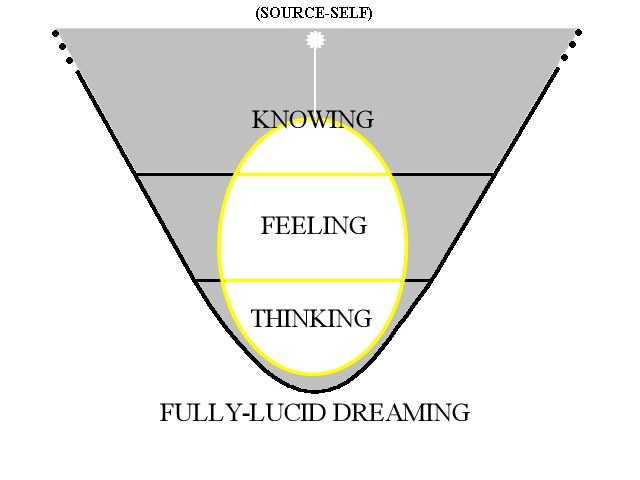
Figure 8
FULLY-LUCID (Figure 8)
fully aware
that I dream and of the location and state of my physical body; I also clearly
remember any lucid dream tasks that I had earlier decided to try (lucid dream
healing, intentionally changing body form, precognition, etc.), and experience a
high level of dream control which gives me the power to do them.
Example:
". . . I wake up in the
[conference dormitory in Santa Cruz], a 'big barn like structure'. Lucid, I see
a [nice looking woman in her 30's with dark straight hair] come into [my room].
I assume I may see another dreaming Association for the Study of Dreams
conference participant . . .I introduce myself and ask her name, she says
something like Spiral Gale. I tell her I know that we dream and stick my hand
through the door to demonstrate. I go out in the corridor looking for other
[ASD dreamers], aware that I may only meet subjective dream characters but eager
to gather possible consensual evidence for mutual dreams . . ." 6/24/92
Comment: In this dream I overtly realized not only that
I dreamed, sleeping brain, or that it might exist in an objective sense
comparable to physical reality, and as such fall subject to consensual
validation. I focused upon the experiential reality in which I lived, and
remained overtly aware of the assumptions that I made when I identified a dream
person with a possible physical reality counterpart, etc. Despite the high
degree of success in applying the epoché, I failed to notice that
the [dream dormitory] did not look at all similar to the [physical reality
dormitory] in which I had gone to sleep. This illustrates that even when fully
lucid, the automatic functioning of my capacity for critical reflection may
still seem impaired (as compared to WPR standards) with regard to objects
not in the forefront of my attention.
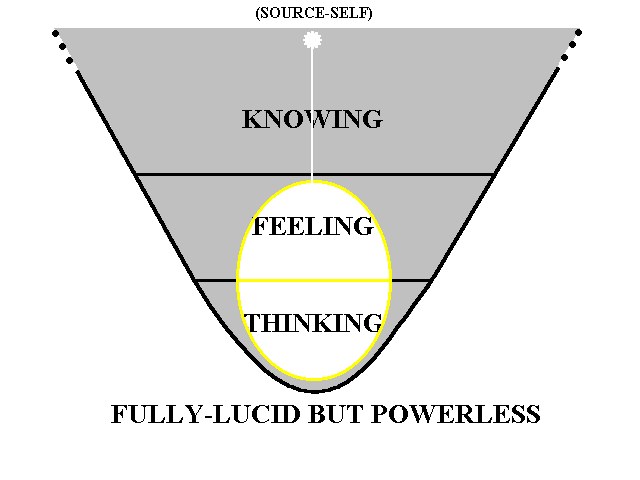
Figure 9
FULLY-LUCID BUT POWERLESS (Figure 9)
fully aware
that I dream and of the location and state of my physical body; also remember
any lucid dream tasks that I had earlier decided to try, but have little or no
control over dream phenomena.
Example:
" . . lying on the bed, I
hear a voice say "lets test him with a few childhood experiences." I hear a
child's awful shriek. I roll over onto floor and check the bed for my (physical)
body (I had intended to have an OBE). I can feel or see none, but
something seems wrong. I go into the kitchen, try to turn on light but it will
not go on. I conclude that I have a lucid dream. Continue to test and go into
the [bathroom]; again I can not turn on the light. So I will the [fluorescent
lights] to go on (noticing the discrepancy between them and their WPR
counterparts) - they flicker, then go on. Bathroom much larger, in blue,
covered with objects, toys, etc. I remember what the voice said. This whole
experience has the atmosphere of nightmare. I look at the door, and the opening
has shrunk. I think "No you don't!" and put my shoulder in the door, but it has
become too small to let me through. I did not want to get shut up in this
cramped space, and somehow make it into the hall. Above my head a grotesque
doll, like a ventriloquists dummy, drops down and hangs in front of me. I pick
it off and wonder if it would speak or walk around. I threw it in the
[bathroom] with other junk, broke the mirrors on either side of me, feeling put
upon and trying for control of this dream. I looked at my [hand] which hurt,
but remained uncut, and wondered if a cut could make the transfer to the waking
world as a psychosomatic occurrence. I ran against a wood-panelled wall of the
[apartment], denting it in a spot, and continued outside to the [front porch],
now high above the ground with a lot of stairs leading down. I knew that I
dreamed but I felt heavy and physical. Decided to jump, but on looking over the
side felt a great fear of the height and turned back. Again I felt imposed
upon, and determined to face this fear, and going back a little ways, I turned
and jumped. At first I felt the fear of falling, but fought that and just
before hitting bottom pulled up and started flying . . ." 10/1/72
Comment: I had to go back in my records to 1972 to find a
dream of this type, and even this example doesn't quite qualify, because I did
achieve a measure of dream control at the end.
I include this dream state not because it seems a typical
one for me, but because others who have a fear of lucid dreaming, or feel
concerned about its dangers, cite nightmarish dreams of this type as reasons why
people should eschew lucid dreaming in general.
In doing so, they "throw out the baby with the bathwater". The
experience of lucidity as a variable aspect of consciousness depends most
closely on two factors that interact to determine the degree of freedom of
choice experienced by the dreamer in the dream. The first corresponds to
clarity of thought and perception, and the second with the power to control the
dream. For the most part I find these two variables covariant: if one
increases, so does the other. I enjoy nightmarish dreams because I've learned
to use them as springboards to that broadening of consciousness that constitutes
a greater and more authentic sense of self.
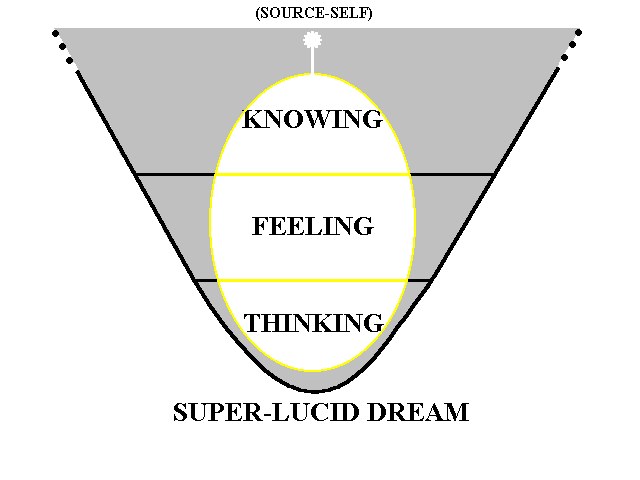
Figure 10
SUPER-LUCID (Figure 10)
I have an
awareness of self as an integrated whole: self-remembering.
Knowing-feeling-thinking aspects of self work in harmony. I feel an
extraordinary sense of self, access to memory, and an expanded and mindful
awareness of the many possible courses of action available to me in lucid dream
reality as compared to waking physical reality.
Example :
". . . [I fly out the front
window to perform my dream tasks (remembering clearly that I wanted to
experiment with the effects of kabbalistic words in dream reality). I race
very fast while chanting . . . and end up in a sort of grassy valley, lose 3/4
of vision, but hang onto kinesthetic sensations until I see - find myself in a
cubic room 10'x10'x10' lined with yellow pine. I decide to continue chanting,
repeat the Rafael chant, then chant to Ra as I see a wall hanging (papyrus?)
that looks vaguely Egyptian, and I think of Ra as a god of healing. I then chant
Geburah and
Gedulah while visualizing red and blue energy spheres in my
consciousness above me: visualization seems clear - did not take the place of
DR environment visually perceived, looked and felt similar (but increased in
quality) to visualization in WPR. Also chanted
Alef while visualizing this path
of self-integration between geburah and chesed.
I don't feel much happening, but like doing the chants. I invoke a mirror to
see myself: it appears when I turn around. I look like an extremely young,
handsome, muscular, and vigorous beast like creature covered almost every where
with dark long hair everywhere except for some white on my chin and forehead.
I look audacious. A young woman, covered with long dark hair like me asks if
I've finished. I say "First, let me ask you your name". She says "Tia" or "Teeda"
and invites me to come in and meet the others like us. I feel extremely
powerful, go into a large lecture hall with bleachers - the others look like me
but smaller, weaker. I see the woman presiding, and jump easily to the top of
the bleachers. An overweight, middle-aged man with a turban climbs up the
bleachers and tries to put a spell on me. "Go to sleep. You feel sleepy" he
says. Angered at his presumption, I project an energyball from my right hand
and push it at him. He looks fearful and realizes that he has made a
miscalculation, (that he did not confront a mere animal, but a
powerful integration of both higher and lower aspects of self). I push him
down the bleachers to the floor, overcoming him. Fearful and stunned, he
remains on the ground as I leap back up and sit down next to a young beast-woman
who says to her companion "Oh, I didn't know Godzilla sat here," sounding
half-mocking, but also, like the others, very impressed with my prowess.]"
1/16/93
Comment: With lucid dreaming the breadth of
consciousness of my self increases, even though the "center of gravity" remains
in feeling, identity focus expands to include both thinking and
knowing aspects. In fact I feel much more myself when fully lucid than I
do ordinarily in WPR. My sense of self increases, as the "bubble of
awareness" expands both into the "knowing" and "thinking" realms into areas
that I do not normally access. This dream had a profound effect on my behavior
for weeks afterward - I felt more vital and alive, and much more in tune with my
physical environment.

Figure 11
POWER DREAMING (NOT-LUCID) (Figure 11)
In power dreaming, although I have little or only limited
use of my thinking aspect, and very little memory of the ordinary state of
affairs of my WPR existence, I exhibit an extraordinary control of dream
phenomena. I can fly, walk through walls, use "the force," and perform
superhuman feats with the greatest of ease.
Example :
"In the evening, I walk across the gray water of San Francisco Bay to a small
resort island. I encounter a young woman and a woman hotel manager. . . I ask
for directions to San Francisco and the older woman obviously doubts that I can
make it. I show her my levitation, how I can walk on water. The younger slim
woman obviously feels fascinated with me, and wants to learn my magic." 3/20/90
Comment: Many people enjoy dreams of this type most of
all. They include such categories as flying dreams, dreams of oneself as
superhuman and displaying amazing psychic, or magical powers, etc. In such
dreams I have a great degree of power to control dream phenomena, but I find my
freedom of choice limited by not having the lucidity necessary to see possible
choices.
CONCLUSION
As stated earlier, the experience of lucidity as a
variable aspect of consciousness depends most closely on two factors that
interact to determine the degree of freedom of choice experienced by the dreamer
in the dream. The first corresponds to clarity of thought and perception, and
the second with the power to control the dream. However, in actual fact
lucidity involves far more than two factors. The diagrams make clear that for
me increased lucidity corresponds with an expansion of the "bubble of
awareness", a widening of consciousness (see John Wren-Lewis, 1985) that brings
about a functional integration of aspects of self. Thus, in a fully lucid
state (Figure 8) one may push the envelope of the bubble to
become a knowing-feeling-thinking self, rather than primarily as a
thinking-self (Figure 3) or a feeling-self (Figure
4). The bubble of awareness represents the "conscious self" for any
particular state. Obviously this "conscious self" can vary markedly from the
"conscious self" with which I ordinarily identify in
wpr. Because of the phenomenon of state specific
learning, this could explain the poor dream recall experienced by many, as the
result of "bubbles of awareness" for the states of "ordinary waking" and
"ordinary dreaming" that have little or no overlap. This may also explain why
lying comfortably in bed after waking up (in an intermediary state) can
facilitate the development of dream recall. Empirical research could validate
portions of this model for the general population.. For example the model would
predict a very low level of cognitive (thinking) elements in the dreams of
non-dream recallers when awakened in a sleep lab when compared to those with
high recall, who would in turn have a lower level of such cognitive elements
than frequent lucid dreamers.
The "Lucidity Continuum" comprises the range through
which the "bubble of awareness" that represents the sense of self expands and
contracts within a field of potential consciousness. The examples given
here only illustrate some of the more common types of "lucid" dreams that I have
experienced. I have also used these maps to model other states of
consciousness, such as "Lucid and SuperLucid Waking" (Figures 12 and 13),
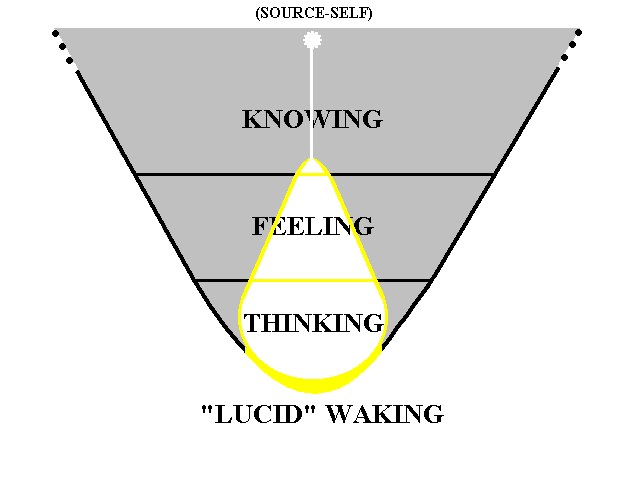
Figure 12
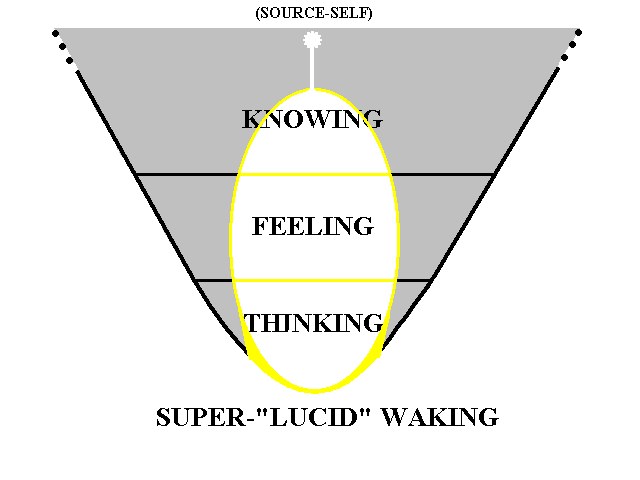
Figure 13
"'Pure' Consciousness" (Figure 14),
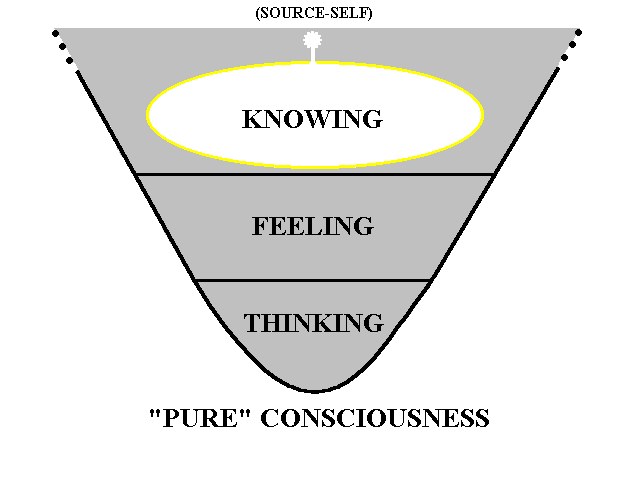
Figure 14
and "Waking 'Pure' Consciousness"(Figure 15)
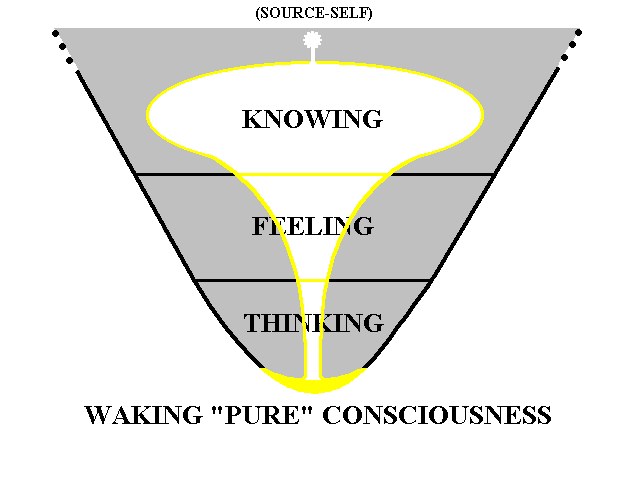
Figure 15
Figure 16, "'Absolute' Lucidity'",
illustrates a theoretical goal towards which I aim.
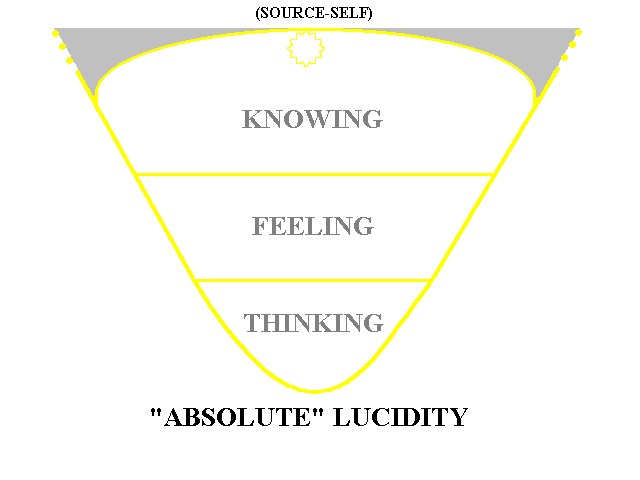
Figure 16
In more complicated diagrams, I have also usefully
divided the parabola from right to left (with a synthesizing function on one
side, and an analyzing function on the other), in order to localize other
factors related to lucidity (see Appendix A) on the diagram.
Despite the fact that I have portrayed the "bubble of awareness" as symmetrical
and static, I did so only because of the limitations of the printed page. In
actuality, it continually shifts and changes: asymmetric and amoebalike, it
extends pseudopodia of awareness, that continually changes the sense of self in
many ways (Figure 17).
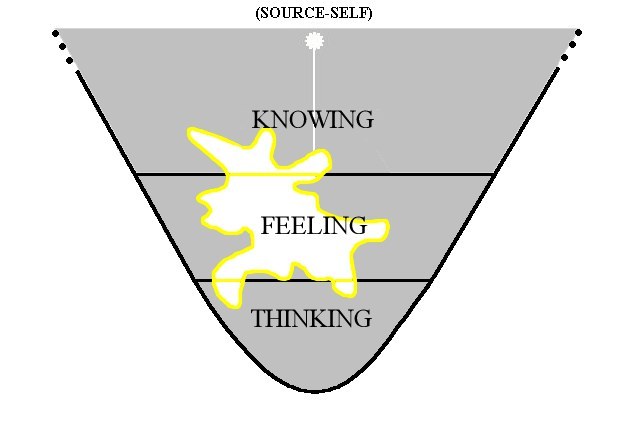
Figure 17
To understand the "Lucidity Continuum" better, one could
imagine a series of these diagrams processed into an animated cartoon where each
figure exists only as an individual frame of an ongoing process. The sense of
self fluctuates widely, but not randomly, predominantly conforming to certain
configurations created through habit, just as we have preferred body postures
created through habit. The thick and thin boundaries questionnaire developed by
Hartman (1990) may serve as a useful diagnostic aid in accessing details of this
process in individuals.
Although the basic "map of consciousness" presented here
may not prove universally applicable, I have used it to portray many kinds of
lucid or non-lucid experience, and as such I have found it a very useful tool.
My maps have received some consensual validation in the sense that lucid
dreamers with whom I have shared them have generally found them valuable as a
means of understanding their own experiences. Lucid dreamers need not limit
themselves to words alone in describing their dreams, and the states of
consciousness in which they experience them. Sometimes a picture can say what
words can not. I hope that my efforts in this direction will inspire other
explorers of the dream state to "map the territory" for themselves.
REFERENCES
Hartmann, Ernest (1990). Thin and thick boundaries:
personality, dreams, and imagination. In Mental imagery, edited by R.G.
Kunzendorf, new York, Plenum Press, 71-78.
Husserl, Edmund (translated by Dorion Cairns) (1973a).
Cartesian meditations: An introduction to phenomenology, The Hague,
Netherlands, Martinus Nijhoff.
Kellogg III, E.W. (1985). The substitution phenomenon.
Dream Network Bulletin, 4(5), 5-7
Kellogg III, E.W. (1989). Mapping territories: A
phenomenology of lucid dream reality. Lucidity Letter, 8(2), 81 -
97.
LaBerge, Stephen (1985). Lucid dreaming. Los
Angeles, Jeremy P. Tarcher, Inc., 219
Natanson, Maurice (1973) Edmund Husserl: Philosopher
for infinite tasks. Evanston, Ill.:Northwestern University Press.
Tart, Charles (1987). Waking up: Overcoming the
obstacles to human potential, Boston, New Science Library, Shamballa
Publications, Inc.
Tholey, Paul (1983). Techniques for inducing and
maintaining lucid dreams. Perceptual and Motor Skills, 57, 79-80.
Wren-Lewis, John (1985). Dream lucidity and near-death
experience - a personal report. Lucidity Letter, 4(2), 4-12
Zaner, Richard M. (1970). The way of phenomenology.
New York, Western Publishing Company, Inc.

APPENDIX A
lucidity correlates*
Although lucidity appears to correlate most strongly
with the awareness of dreaming and with the implications that follow this
awareness, a number of other factors also play important roles. please rate
your experience in the lucid dream on a scale from 0 to 5 in each of the
following specific areas:
THINKING:
confers labels
LABELING. MY ABILITY
TO CORRECTLY LABEL OBJECTS SEEMED:
___ 0 NONEXISTENT
___ 1 POOR
___ 2 FAIR
___ 3 GOOD - EQUIVALENT TO IN WPR.
___ 4 EXCELLENT - BETTER THAN IN WPR.
___ 5 EXTRAORDINARY.
ABILITY TO THINK. MY
THINKING ABILITY IN THE LUCID DREAM SEEMED:
___ 0 NONEXISTENT
___ 1 POOR
___ 2 FAIR
___ 3 GOOD - EQUIVALENT TO IN WPR.
___ 4 EXCELLENT - BETTER THAN IN WPR.
___ 5 EXTRAORDINARY.
EGO INVOLVEMENT. IN
THE LUCID DREAM I SEEMED:
___ 0 TOTALLY PASSIVE - THINGS JUST HAPPENED.
___ 1 VAGUELY ACTIVE, BUT MOSTLY WENT WITH THE FLOW.
___ 2 SOMEWHAT ACTIVE, MADE A FEW CHOICES.
___ 3 AS ACTIVE IN MAKING CONSCIOUS CHOICES AS IN
wpr
___ 4 MORE ACTIVE THAN IN WPR.
___ 5 EXTREMELY ACTIVE. MANY CONSCIOUS CHOICES AND
BEHAVIORS.
MEMORY. DURING THE
LUCID DREAM I WOULD RATE MY MEMORY AS:
___ 0 NONEXISTENT
___ 1 POOR
___ 2 FAIR
___ 3 GOOD - EQUIVALENT TO IN WPR.
___ 4 EXCELLENT - BETTER THAN IN WPR.
___ 5 EXTRAORDINARY.
FEELING:
confers meaning
EMOTIONAL TONE. IN THE
LUCID DREAM I FELT:
___ 0 NEUTRAL - NO EMOTION AT ALL.
___ 1 VAGUE EMOTION
___ 2 MILD EMOTION
___ 3 MODERATE EMOTION
___ 4 STRONG EMOTION
___ 5 OVERWHELMING EMOTION
WHAT KIND(S) OF EMOTION DID YOU
EXPERIENCE DURING THE LUCID DREAM?
___ ANXIETY ___
FEAR
___ ANGER ___
SADNESS
___ CURIOSITY ___
PEACEFULNESS
___ A SENSE OF WELL-BEING ___ HAPPINESS
___ JOY ___
ECSTASY
___ OTHER (PLEASE DESCRIBE:
________________________________________)
SENSE OF EMBODIMENT.
DURING THE LUCID DREAM I FELT:
___ 0 TOTALLY DETACHED - NO AWARENESS OF A DREAM BODY.
___ 1 DETACHED, OBSERVED MY DREAM BODY FROM THE
OUTSIDE.
___ 2 VAGUELY AWARE OF MYSELF IN MY DREAM BODY.
___ 3 AS EMBODIED AS IN WAKING PHYSICAL REALITY.
___ 4 MORE EMBODIED THAN IN WPR.
___ 5 FULLY PRESENT IN MY DREAM BODY. AWARE OF MY
DREAM BODY
IN GREAT DETAIL - IT FELT "REALER THAN REAL".
knowing-creating: confers structure
DREAM CONTROL. IN THE
LUCID DREAM I HAD:
___ 0 NO CONTROL OF ANYTHING.
___ 1 MINIMAL CONTROL OF MY DREAM BODY AND DREAM
ENVIRONMENT.
___ 2 GOOD, BUT MUNDANE CONTROL OF DREAM BODY AND
ENVIRONMENT.
___ 3 SUPERIOR CONTROL - ABLE TO FLY, WALK THOUGH
WALLS, ETC.
___ 4 "MAGICAL" CONTROL - COULD CHANGE DREAM BODY,
DREAM
ENVIRONMENT MORE OR LESS AS I WISHED.
___ 5 EXTRAORDINARY CONTROL - MY EVERY WISH CAME TRUE
reality tone. THE DREAM
EXPERIENCE SEEMED:
___ 0 TOTALLY UNREAL.
___ 1 SLIGHTLY REAL - LIKE A GOOD MOVIE.
___ 2 MODERATELY REAL.
___ 3 AS REAL AS ORDINARY WPR.
___ 4 EVEN MORE REAL THAN WPR.
___ 5 OVERWHELMINGLY REAL.
SENSE OF SIGHT. DURING
THE LUCID DREAM I SAW:
___ 0 NOTHING.
___ 1 DETACHED, OBSERVED MY DREAM BODY FROM THE
OUTSIDE.
___ 2 POORLY. VAGUE SHAPES AND DIM LIGHTING.
___ 3 AS CLEARLY AS IN WAKING PHYSICAL REALITY.
___ 4 CLEARLY IN SHARP DETAIL. VIVID COLORS.
___ 5 WITH SUPERNATURAL CLARITY - PSYCHEDELIC
INTENSITY.
SENSE OF SELF. DURING
THE LUCID DREAM I HAD:
___ 0 NO AWARENESS OF SELF, ONLY OF THE DREAM.
___ 1 VERY LITTLE SENSE OF SELF; LIKE WHEN I WATCH
TELEVISION.
___ 2 MODERATE SENSE OF SELF - BUT "SPACEY" - NOT VERY
"WITH IT".
___ 3 SENSE OF SELF AS IN ORDINARY WPR.
___ 4 I FELT MORE REAL, MORE PRESENT THAN IN WPR.
___ 5 I FELT TRULY "MYSELF", MORE COMPLETE THAN EVER
BEFORE.

* Note: the lucidity correlates given
here comprise only a part of the "Lucid Dream Healing Questionnaire" that I also
presented as part of a talk given at the Association for the Study of
Dreams Conference in Santa Cruz in 1992. Copies of this longer
questionnaire available from the author by request.
Address correspondence to:
E. W. Kellogg III, Ph.D
The Phenomenological Laboratory
P.O. Box 1019
Ashland, Oregon
Tel: (503) 535-7187
Email:
alef1@msn.com
|

